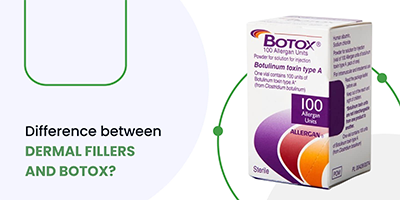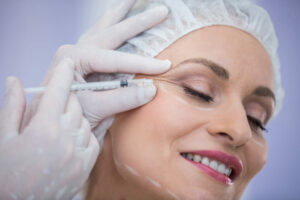
Contents
Among a wide range of cosmetic treatments, both dermal filler and Botox injections remain at the top. A huge number of people all around the world resort to these procedures in order to remain “young and beautiful” for as long as it is possible.
But what exactly is a dermal filler? What is Botox? In how far are they similar? And, finally, what is the key difference between them? Let’s find answers to these questions by means of putting dermal fillers and Botox side-by-side.
In order to compare and contrast dermal fillers and Botox, it is essential to define both notions. So, how about taking a detailed look at them right away?
A dermal filler is an injectable gel-like product that is used to “fill in” age-related signs and enhance a patient’s overall beauty. Depending on its main active substance, it might be divided into the following sub-types:
While some of the above-mentioned sub-types of dermal fillers derive from natural-occurring substances, others are synthetically produced. Also, a product might either contain or do not contain a local anesthetic (such as lidocaine) in its composition.
Among the most well-known and widely-spread brands of dermal fillers are:
The nature of the main active substance of a dermal filler treatment influences the duration of its result. On average, a single injection of a product provides a patient with a durable effect that lasts for up to 24 months.
However, the exact duration of a dermal filler effect depends not only on the product itself but also on the following peculiarities of each patient:
Therefore, the time period for which a dermal filler will last is highly individual.
While having a wide range of indications, dermal filler injections are primarily used to:
Apart from the above-mentioned purposes, most dermal fillers have the power to stimulate natural collagen and elastin production. As a result, they are used to moisturize a patient’s skin tissue “from within.”
In most cases, dermal filler injections might be applied to the following body and face areas:
Therefore, dermal fillers work best when it comes to treating static wrinkles, adding volume to certain areas, and volumizing lips.
The working principle of dermal fillers is pretty straightforward: After being administered, they do not only fill in skin imperfections and moisturize skin tissue but also activate natural collagen and elastin production. As a result, a patient gets smooth, well-hydrated, and elastic skin.
A great advantage of dermal filler injections is that they require little to no downtime. As well, they rarely lead to serious complications. In some cases, a patient might experience skin irritation, redness, or bruising for a short period of time after the injection. However, they tend to disappear on their own within a short period of time after the procedure.

Botox is an injectable drug that is used for both medical and cosmetic purposes. Namely, it is a product that is based on botulinum toxin type A, which is a natural substance produced by the Clostridium botulinum bacterium.
A side note: In rare cases, the above-mentioned Clostridium botulinum bacterium might cause a very dangerous disease called botulism. It is characterized by muscle weakness, tiredness, blurred vision, and other symptoms. In the most severe cases, botulism might turn out to be fatal.
Amond the main medical purposes of Botox injections are the treatments of:
As well, a product might also be injected as a part of medical procedures that are used to treat excessive sweating, teeth grinding, or heavy migraines.
While the primary cosmetic purposes of Botox treatments include:
Therefore, the cosmetic treatment that employs Botox is oftentimes applied to the following areas of a patient’s body or face:
As a result, a patient gets a profoundly rejuvenated and embellished appearance, especially when it comes to the reduction of dynamic wrinkles that appeared as a result of aging or too active facial expressions.
When discussing the duration of Botox results, it is essential to mention that it also depends on a number of individual peculiarities of a patient. On average, the effect of a product’s injection lasts up to 6 months.
The most widely-spread brands of cosmetic botulinum toxin-based injectables include:
Please note that none of the above-mentioned brands contains a local anesthetic in its composition. However, a health care practitioner might still apply a numbing cream before a Botox injection to minimize the unpleasant feelings of a patient.
Here is how a cosmetic implication of botulinum toxin works: Botox injections relax body muscles in the treatment area for a certain time period. They do so by means of blocking nerve signals in certain parts of the body and face. As the affected muscle relaxes, its skin imperfections become smoother and way less visible. So, a patient gets soft skin without age-related signs.
Botox injections are considered to be minimally invasive and safe. Therefore, they do not require any substantial downtime in most cases. A patient might still experience skin numbness, redness, and irritation for a short period of time after the Botox treatment. However, it rarely leads to serious complications that require medical assistance.
Based on the above-mentioned description of Botox and dermal fillers, we might draw the following parallels between them:
Thus, both Botox and dermal fillers are among the most extensively-used and efficient aesthetic medicine procedures that help a patient to acquire a more youthful appearance.

Despite all the similarities between dermal fillers and Botox that are mentioned above, they are far away from being identical. Both products have a substantial number of differences, such as:
Therefore, cosmetic procedures that involve Botox and other brands of dermal fillers have a wide range of differences, starting from their main active substance and ending with their price.
A side note: Based on the above-mentioned similarity and difference between Botox and a dermal filler, a health care practitioner will be able to define what type of products might serve as the best treatment for a certain patient. For instance, it might be dangerous to administer Botox in case a patient has genetically weak facial muscles (since it will block muscle movement even further). Still, this patient might undergo a dermal filler injection to treat such age-related signs as lines and wrinkles, as it does not work as a muscle relaxer.
All in all, Botox and dermal filler injections are efficient procedures of aesthetic medicine. While having a lot of similarities, they are at the same time quite different. Anyway, both dermal fillers and Botox might substantially rejuvenate your appearance. So, prevent wrinkles and enhance your beauty by undergoing any of the procedures!